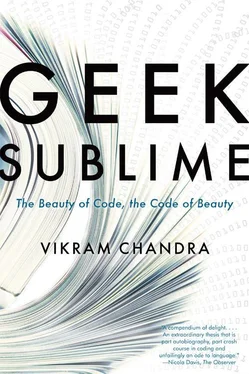A hundred times more likely —emphasis doubly mine and in the original — would seem to indicate that within the American idiom of personhood, power, desire, and meaning, there is a figuring of mathematics as male, something that “Non-Hispanic white girls” should keep away from. Something similar seems to be true of programming in America, which is marked by a particular machismo that idealizes un-socialized, high-school-outcast geekery; coding excellence earned through solitary, singular focus; and adult programmer-bro success signaled by aggression.
So within this American landscape, on this new frontier, how do those who are not “cool” (or belong to the wrong gender) succeed? N. Sivakumar, the immigrant programmer who was warned about shabbiness, tried to learn coolitude: “All right, I am going to walk straight and smart as of tomorrow!” But his colleagues now teased him for walking like “President Bush,” and so he decided, “I better be me!” 79But being himself and succeeding required that he work very, very hard, and adopt certain strategies:
Indians learn for survival whereas most Americans tend to choose their career for passion. Indians learn everything …
Indian programmers have a habit of saying “yes” to everything. Again, it’s all about survival. They will say “Yes” to move to North Dakota tomorrow. Say “Yes” to work for someone who used to work for him. “Yes” to long hours. “Yes” to program in a completely new language (which they will starve to learn within days) …
Indian programmers are also tolerant enough to do the “shit” work. That is: going through somebody else’s code. This is one of the toughest challenges for any programmer …
Almost all the so-called “software maintenance” projects … were handled by Indian programmers …
This is what Indian programmers do and are patient enough to handle. Patience — a unique quality of Indians. 80
N. Sivakumar is careful to qualify his assertions; he’s not saying that every Indian programmer is preternaturally patient and a paragon of hard work: “My comparisons … always focus on the average programmer … There will always be a good and a bad and an ugly in every bunch.” He adds:
An Indian programmer will most probably stop learning once he gets a job … Indian programmers are least likely to learn something new on their own — in their field of interest — to enhance their knowledge if not required. In other words, they lack initiative once they are settled and once they feel safe. 81
And finally:
Average American programmers are more innovative than their counterparts. I know my Indian and Chinese friends will disagree with me on this, but this is the truth. Although an average American programmer’s knowledge is limited to a certain technology or a programming language, they master the hell out of that, and have a higher probability of innovating something new in their area. Average Indian and Chinese programmers, on the other hand, tend to be all over the place and are least likely to innovate something new in their specific area. 82
In reference to the success of Indians in Silicon Valley, the tech entrepreneur and academic Vivek Wadhwa credits efficient and ceaseless networking:
The first few [company founders] who cracked the glass ceiling had open discussions about the hurdles they had faced.
They agreed that the key to uplifting their community, and fostering more entrepreneurship in general, was to teach and mentor the next generation of entrepreneurs.
They formed networking organizations to teach others about starting businesses, and to bring people together. These organizations helped to mobilize the information, knowhow, skill, and capital needed to start technology companies …
The first generation of successful entrepreneurs — people like Sun Microsystems co-founder Vinod Khosla — served as visible, vocal, role models and mentors. They also provided seed funding to members of their community. 83
These efforts were successful enough that the denizens of Silicon Valley sometimes refer to these networks, with decidedly mixed admiration and resentment, as the “Indian Mafia.” 84
The resentment curdles and boils over in discussions of outsourcing. Since the nineties, American companies have gained commercial advantage by leveraging the new landscape of instant communication made possible by the internet and the disparities in programmer salaries around the globe. If you can manage employees via e-mail and Skype, it makes economic sense to have your code written in Bangalore rather than next door, and pay a fraction of the salary that a programmer living in San Jose would demand. American programmers have watched with mounting fear and fury as work has been outsourced; meanwhile, in India, the demand for competent programmers has steadily driven wages up. On American websites frequented by programmers, stories about horrible, ugly code written by Indian coders function as reliable linkbait. The ensuing discussions speedily descend into outright racism (’code coolies’) and nationalist chest-thumping (’go look for all the Indian names on the Google corporate masthead’). It is certainly true that Indian consulting companies struggling to keep up with the demand from overseas have hired battalions of Indian Morts, who have written some truly awful code, although I doubt that it’s any worse than code written by American Morts. The corporate imperative toward cost-cutting — on both sides of the globe — results in shoddy products, in programming as in any other industrialized field. And the Indian Einsteins, until fairly recently, have gravitated inevitably toward Silicon Valley, often snapped up directly from Indian campuses by American recruiters. There, they have formed the core of the Indian Mafia.
So this is another history of success in Silicon Valley that may be placed beside the more familiar narrative of solitary, pioneering heroes who seem to have sprung from an Ayn Rand novel — in this Indian-American version we have a tenacious patience, learned in a country with sparse resources and endless competition, a perseverance trained and honed by a thousand endless queues in government offices; a willingness to work at “shiz” scorned by people conditioned by a less straitened environment; cooperation and mutual help; and a huge, continuing financial investment by a young nation state, despite the paradoxes of unequal development and the flight of intellectual capital. This alternate narrative of technology should remind us that there are always many pasts, some hidden in plain sight.

The fictions about history that form the Frontier Myth, the stories that the Gunfighter Nation tells itself, typically present women as dauntless housewives or prostitutes (with the requisite hearts of gold). In either case, they are the backdrop, they inhabit the fragile outposts of civilization (the parlor, the schoolhouse, the saloon) on whose behalf the silent hero enacts his all-important rituals of violence out on the mesa. Men do the thinking and planning, women provide — as it were — the clerical support. Much scholarship since the seventies — the New Western History — has unearthed the complex roles women played on the frontier, their essential and irreplaceable contributions to the logistics and politics of the westward expansion. Notwithstanding revisionist historians and filmmakers, the power of the Frontier Myth, its meaning-making about nation and personhood, its celebrations of regeneration through confrontations with savagery and the wilderness — all this remains intact, as one can see on television shows and hear in the speeches of politicians.
The mythology of computing similarly celebrates the victories of its male protagonists and erases women from the record, and not just programmers. The programmer Jaron Lanier tells us that in the early days of Silicon Valley
Читать дальше













